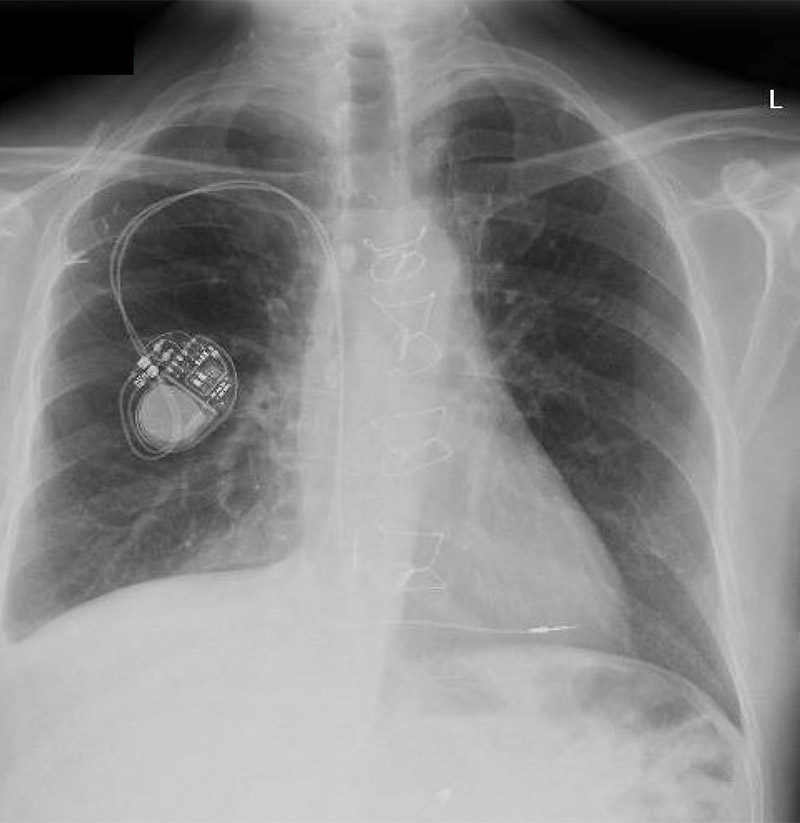As many as 10% of heart transplant recipients may receive a permanent pacemaker to treat sinus node dysfunction or atrioventricular block; however, the need for these devices has changed with the evolution of heart transplantation surgical approaches. Analyzing data from patients who received modern heart transplantation surgery, cardiologists and cardiothoracic surgeons from NewYork-Presbyterian/

Standard posterior-anterior (PA) chest x-ray is shown from a transplant recipient requiring permanent pacemaker implantation for sinus node dysfunction.
How Bicaval Transplantation Affects Arrhythmia Risk
Prior investigations analyzing long-term outcomes of patients who receive a pacemaker included those who had biatrial transplants as well as patients who had bicaval transplants. With the biatrial approach, which was popular until the early 1990s, the atria were divided mid-level so both the donor and recipient atria were retained. Patients who had undergone this procedure were more likely to have postoperative sinus node abnormalities and lower resting sinus heart rates, likely due to trauma to the sinus node or its blood supply because of the proximity of this node to the suture lines. Today, however, the biatrial approach has been replaced by bicaval anastomosis, which does not preserve the recipient atria and results in less manipulation of atrial tissue. As a result, there is less need for permanent pacing.
In the current study, Ersilia DeFilippis, MD, a NewYork-Presbyterian/
Of 1,082 heart transplant recipients, 41 (3.8%) received permanent pacemakers. The median time from transplantation to pacemaker implantation was 118 days. The most common indications were sinus node dysfunction (60%) and atrioventricular nodal disease (41.5%). Post-implantation complications included pocket hematoma in three patients, lead under-sensing in two patients, and pocket infection requiring explant in one patient.
Doctors may be quick to put a pacemaker in early after transplant, but when we look at these patients a year later, very few are pacemaker dependent.
— Dr. Ersilia DeFilippis
Mortality and re-transplantation rates 10 years after transplant were similar between the two groups. After adjustment for mechanical circulatory support, pretransplantation amiodarone use, donor ischemic time, and age, only older donor age was associated with an increased risk of permanent pacemaker implantation.
Trying Oral Medications First
There was a significant decrease in pacemaker placement after 2018 (1.2% versus 4.4%) as doctors observed less need for this intervention and scaled up the use of medical treatments to manage heart rate abnormalities in the early weeks after transplant. Since the need for permanent pacing wanes a month after a bicaval transplant, fewer patients may need the device. “Doctors may be quick to put a pacemaker in early after transplant, but when we look at these patients a year later, very few are pacemaker dependent,” Dr. DeFilippis explains. “That begs the question, could pacemaker implantation have been avoided in the first place?”
Specifically, sinus node dysfunction tends to occur early after transplant and improve with time after transplant. Now physicians can select from a roster of medications — such as terbutaline, theophylline, or cilostazol — to treat transplant patients with early sinus node dysfunction, potentially sparing them from or delaying the need for a permanent pacemaker.
Patients who experience arrhythmias later, however, are more likely to require a permanent pacemaker. “They aren’t necessarily pacemaker dependent, but they’re usually pacing more than the patients who have heart rate issues early after transplant,” notes Dr. DeFilippis.
When a Permanent Pacemaker Is Warranted
Late sinus node dysfunction may result from cardiac allograft vasculopathy, with ischemia to the sinoatrial node. Sinus node dysfunction related to rejection has a poor prognosis. High-grade atrioventricular block is more likely to develop six or more months after transplant and is related to advanced donor age and a longer operative time. The latter may indicate a more complex operation with prolonged aortic cross clamping that may have triggered injury to the sensitive conduction system. Permanent pacing is warranted in these patients.
We always want to be sure that a reduction in heart rate post-transplant is not a manifestation of organ rejection. If cardiac output is adequate and testing is not consistent with rejection, it is worth being patient and trying oral agents before deciding that the patient needs a permanent pacemaker
— Dr. Ersilia DeFilippis
This study was one of the few reporting on post-procedure complications. “Even though these patients are on immunosuppressants, we found that the rates of complications were low and, as far as we can tell, similar to complication rates among recipients of pacemakers who have not had a heart transplant.
“Sometimes after transplantation, the heart’s electrical system is a little slow to wake up,” Dr. DeFilippis adds. “For all patients, we always want to be sure that a reduction in heart rate post-transplant is not a manifestation of organ rejection. If cardiac output is adequate and testing is not consistent with rejection, it is worth being patient and trying oral agents before deciding that the patient needs a permanent pacemaker.”
World Leadership in Heart Transplantation
NewYork-Presbyterian/



